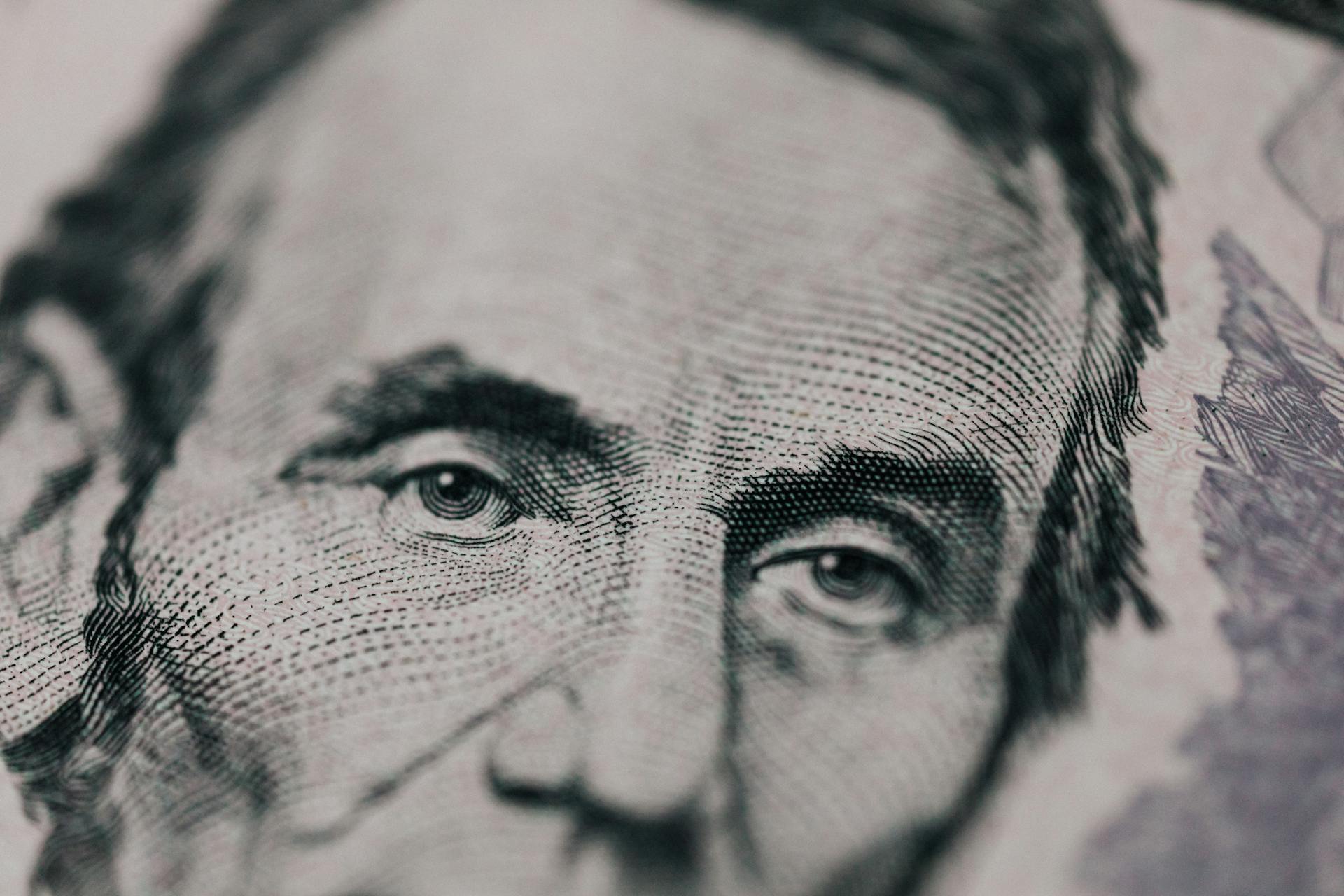
Dollar diplomacy was a foreign policy strategy employed by the United States in the early 20th century to exert influence abroad through economic means, rather than military force.
This approach was pioneered by President William Howard Taft, who believed that economic cooperation and investment could be a more effective way to promote American interests and spread democracy.
The idea was to use American capital to modernize and develop foreign economies, creating a sense of interdependence and mutual benefit.
In practice, dollar diplomacy involved providing loans and investments to countries in need, often with the condition that they adopt American-friendly policies and business practices.
Explore further: Foreign Exchange Certificate
Taft's Dollar Diplomacy
Taft's dollar diplomacy was a foreign policy strategy that relied on U.S. economic might to achieve its goals.
Taft sought to use U.S. economic power as a lever in foreign policy, often threatening or using military force when economic coercion proved unsuccessful. He tried to use American banking power to create a tangible American interest in China, but this effort backfired and alienated Japan.
You might like: How Much Is 1 Usd in Naira
Taft's administration sent warships carrying 2,000 U.S. Marines to Nicaragua to put down an insurrection, suppressing the rebellion and deporting its leaders. A contingent of Marines remained in Nicaragua until 1925 to "stabilize" the government.
Taft's dollar diplomacy was a failure everywhere, including in the Far East, where it alienated Japan and Russia, and created a deep suspicion among other powers hostile to American motives.
East Asia Crisis
Taft's Dollar Diplomacy was a disaster in East Asia, where it was used to create a tangible American interest in China that would limit the scope of other powers. This led to increasing tensions between the United States and Japan, which would eventually explode into World War II nearly thirty years later.
The policy was based on the false assumption that American financial interests could mobilize their potential power in East Asia, but the American financial system was not geared to handle international finance. This led to a series of failed attempts to use economic coercion to achieve American goals.
If this caught your attention, see: East African Currency
The Hukuang international railway loan, made by the China Consortium in 1911, was one of the few successes of Taft's Dollar Diplomacy, but it also helped spark a widespread "Railway Protection Movement" revolt against foreign investment that overthrew the Chinese government. This revolt was a major setback for the United States and its interests in China.
The bonds from the Hukuang loan caused no end of disappointment and trouble, with over 300 American investors trying, unsuccessfully, to force the government of China to redeem the worthless bonds as late as 1983. This was a direct result of the failed policies of Taft's administration.
You might enjoy: What Are Us Treasuries
Nicaragua
Taft's dollar diplomacy was put to the test in Nicaragua, where he sent 2,000 U.S. Marines to suppress a rebellion against the American-friendly government of President Adolfo Díaz.
The Marines remained in Nicaragua until 1925 to "stabilize" the government, indicating the long-term commitment of the U.S. to enforcing its economic interests in the region.
Taft's actions in Nicaragua demonstrate the willingness of the U.S. to use military force to protect its economic interests, even if it means intervening in the internal affairs of another country.
The U.S. government's involvement in Nicaragua highlights the far-reaching effects of dollar diplomacy, which can lead to military involvement and a lasting impact on the relationship between the U.S. and other countries.
Consider reading: Series B Banknotes
Learning Objectives
To understand dollar diplomacy, you need to know who supported the idea. President William Howard Taft and Secretary of State Philander C. Knox created the U.S. foreign policy in 1912.
Dollar diplomacy sought to bolster the struggling economies of Latin American and East Asian countries while also expanding U.S. commercial interests in those regions. This involved U.S. interference in Nicaragua, China, and Mexico to protect American interests.
To score well on the AP US History exam, you should understand the context of dollar diplomacy, including the impact of different historical events. For instance, you should recognize how Teddy Roosevelt's policies led to dollar diplomacy.
Intriguing read: How Much Is an Uncirculated American Eagle Silver Dollar Worth
The lasting effects of dollar diplomacy were far-reaching, including revolts and civil wars in those countries, which eventually led to U.S. military involvement. The response to dollar diplomacy in the United States was isolationism, leading the U.S. to limit contact with other countries.
Here are the key takeaways about dollar diplomacy:
- Dollar diplomacy refers to the U.S. foreign policy created by President William Howard Taft and Secretary of State Philander C. Knox in 1912.
- Dollar Diplomacy sought to bolster the struggling economies of Latin American and East Asian countries while also expanding U.S. commercial interests in those regions.
- U.S. interference in Nicaragua, China, and Mexico in order to protect American interests are examples of dollar diplomacy in action.
- Despite some successes, dollar diplomacy failed to achieve its goals, resulting in the term being used negatively today.
Overview
President William Howard Taft and Secretary of State Philander C. Knox implemented a foreign policy called "dollar diplomacy" from 1909 to 1913.
"Dollar diplomacy" was a policy where American influence was exerted primarily by American banks and financial interests, supported in part by diplomats.
Taft shared the view held by Knox that the goal of diplomacy should be to create stability abroad and promote American commercial interests.
Knox felt that the goal of diplomacy was not only to improve financial opportunities but also to use private capital to further U.S. interests overseas.
"Dollar diplomacy" was evident in extensive U.S. interventions in Venezuela, Cuba, and Central America, especially in measures undertaken to safeguard American financial interests.
Explore further: PNC Financial Services
In China, Knox secured the entry of an American banking conglomerate, headed by J.P. Morgan, into a European-financed consortium financing the construction of a railway from Huguang to Canton.
Taft's dollar diplomacy allowed the United States to gain financially from countries but restrained other foreign countries from reaping any sort of financial gain.
The US Government felt obligated, through dollar diplomacy, to uphold economic and political stability.
Taft maintained an activist approach to foreign policy, initiating what became known as dollar diplomacy, in which the United States used its military might to promote American business interests abroad.
Taft defended his dollar diplomacy as an extension of the Monroe Doctrine.
Recommended read: Countries with Usd Currency
Geographical Focus
The United States focused its dollar diplomacy efforts in the Americas, specifically in Central America and the Caribbean.
The Roosevelt Corollary to the Monroe Doctrine in 1904 marked the beginning of this approach, with President Theodore Roosevelt stating that the US had the right to intervene in any nation in the Western Hemisphere that was vulnerable to European control.
Central America was a key region of focus, with President Taft attempting to establish control over Honduras in 1909 by buying up its debt to British bankers.
Explore further: America the Beautiful Silver Bullion Coins
The Americas
The Americas was a region of great concern for the United States in the early 20th century. Outgoing President Theodore Roosevelt laid the foundation for U.S. intervention in the region with his Roosevelt Corollary to the Monroe Doctrine in 1904.
This approach was continued and expanded by President Taft, who justified intervention in Central America as a means to protect the Panama Canal. In March 1909, Taft attempted to establish control over Honduras by buying up its debt to British bankers.
The Caribbean was another trouble spot, with many countries plagued by revolution and instability. The United States hoped to head off trouble by pumping dollars into the financial vacuum in countries like Honduras and Haiti.
The State Department played a key role in this effort, persuading four U.S. banks to refinance Haiti's national debt. This move set the stage for further intervention in the region in the future.
The U.S. government was determined to prevent foreign nations from intervening in the Americas, and felt obligated to take action to prevent economic and political instability.
China
China was a key focus for Taft's dollar diplomacy efforts. He helped China secure international loans to expand its railroad system, which initially succeeded in bolstering the country's economy.
However, Taft's plan to involve American businesses in Manchuria ultimately backfired. Japan and Russia, who had shared control of the area since the Russo-Japanese War, were outraged by Taft's proposal and it collapsed.
Taft's failure in Manchuria exposed the limitations of the U.S. government's global influence and knowledge of international diplomacy.
You might enjoy: International Use of the U.S. Dollar
Taft's Policy Introduction
In 1910, President Taft's first year in office, the Mexican Revolution threatened U.S. business interests.
Taft proposed his "dollar diplomacy" to protect U.S. corporate interests around the globe.
This approach was a departure from President Roosevelt's more aggressive "carry a big stick" policy.
Taft's dollar diplomacy aimed to secure U.S. economic interests through diplomacy rather than military force.
It was a calculated move to safeguard U.S. business investments and influence in foreign countries.
If this caught your attention, see: Oregon Business Insurance
Glossary and Review
Dollar diplomacy was President Taft's strategy of using American economic power to push for favorable foreign policy agreements. He used this approach to exert control over foreign markets and governments.
Taft's opponents in the U.S. Senate coined the term "dollar diplomacy" to describe his use of financial resources for this purpose. This occurred during his presidency between 1909 and 1913.
Some Central American nations objected to Taft's paying off their debt to Europe with U.S. dollars. This move created economic instability in the region and fueled nationalist movements driven by resentment of America's interference.
Taft's policies had significant impacts on countries with lower economic status. He was particularly interested in expanding U.S. influence in China and Latin America.
The Lodge Corollary disallowed a negotiation between two countries. Unfortunately, the article doesn't specify which countries were involved in this negotiation.
Taft's foreign policy created troubles for the United States that would not bear fruit until decades later. These troubles included heightened tensions between Japan and the United States, which ultimately contributed to the outbreak of World War II.
Taft's policies relied on the financial strength of the U.S. This strength was particularly felt in countries with lower economic status.
You might like: Foreign Currency Reserve of Pakistan
Frequently Asked Questions
What is the dollar diplomacy in simple terms?
Dollar diplomacy refers to a foreign policy where the US uses its financial influence, primarily through American banks and businesses, to exert its power abroad. This approach was used from 1909 to 1913 under President William Howard Taft's administration.
What were the advantages and disadvantages of dollar diplomacy?
Dollar diplomacy can promote economic development, political influence, and humanitarian aid, but it can also create dependency, political instability, and unintended consequences. Its effectiveness depends on careful implementation and consideration of its potential impact.
Sources
- https://courses.lumenlearning.com/wm-ushistory2/chapter/tafts-dollar-diplomacy/
- https://en.wikipedia.org/wiki/Dollar_diplomacy
- https://pressbooks-dev.oer.hawaii.edu/ushistory/chapter/tafts-dollar-diplomacy/
- https://www.albert.io/blog/dollar-diplomacy-ap-us-history-crash-course/
- https://www.thoughtco.com/dollar-diplomacy-4769962
Featured Images: pexels.com


